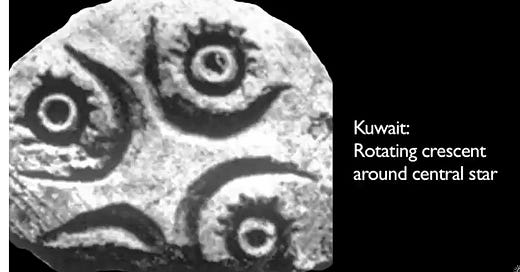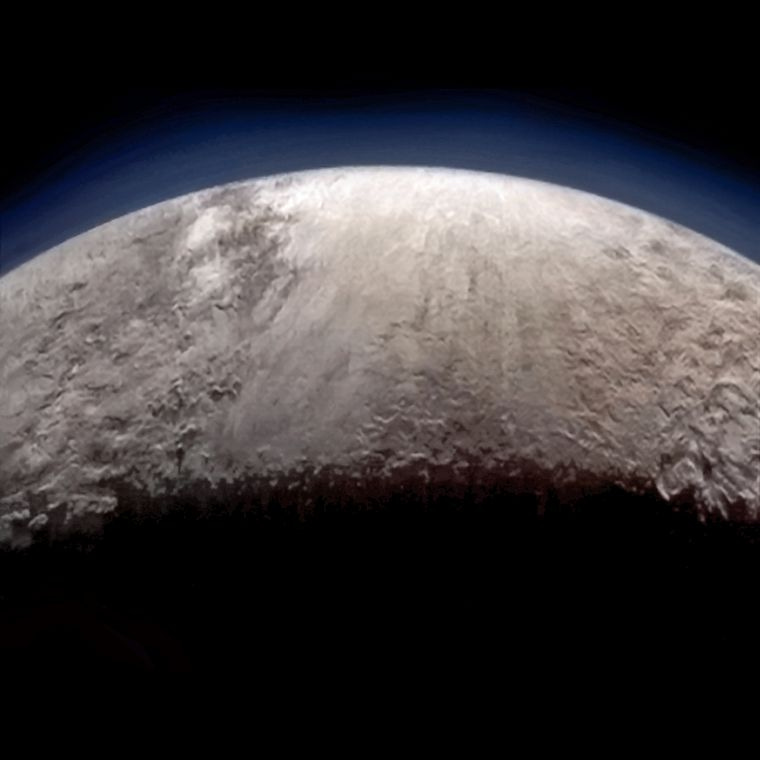In this paper, I seek to determine what would have been required for Polar Saturn to have had a constant sunlit crescent shape on its limb, as viewed from Earth as part of the Saturn Train.
CONTENTS
ROCK ART CRESCENTS (UPDATE: 3/2/25)
NECESSARY ANGLE FOR A CRESCENT
CRESCENT ORBITAL REQUIREMENT (UPDATE: 3/2/25)
WAS THE SATURN TRAIN FARTHER AWAY?
DRISCOLL’S MODEL DOESN’T WORK? (& UPDATE: CONCLUSION)
SUMMARY: The Saturn Crescent in ancient art suggests that the crescent was a constant feature of Saturn for some years, which seems to suggest that the Saturn Train was on a fairly straight path toward the Sun for some years.
THE ANCIENT POLAR TRIO
Dave Talbott published “The Saturn Myth” in 1980 after studying ancient mythology to determine if Velikovsky’s conclusions in “Worlds in Collisions” were correct or not. He found that Velikovsky was likely right that Earth was a satellite of Saturn in early times and that Venus and Mars have near collisions with Earth and each other, but his dating of the events was too late. Dave also found that Mars was likely in front of Venus, which was in front of Saturn, above Earth’s north pole. I’ve lately started referring to this alignment as the Polar Trio. There was a bright crescent on Saturn from sunlight, which appeared to revolve around Saturn as the Earth rotated. A crescent was not seen on Venus, perhaps because Venus was emitting a very bright light of its own. A crescent may have been seen on Mars, but I don’t know if there is any ancient art that depicts that. Saturn’s crescent looked like a boat sailing in a circle around the Polar Trio. It also resembled cow horns etc.
SATURN’S CRESCENT
Ancients in Kuwait area apparently depicted the Polar Trio with the Saturn crescent in the 4 main phases all on one tablet. Saturnists suspect that those phases occurred each day as Earth rotated.
The above 4 images are simulations from the video, “Discourses on an Alien Sky #12 | Turning Crescent & Pillar of the Sky”. This shows that the Polar Trio and the crescent were brightest and clearest to see at night, when viewers on Earth had rotated into darkness. The first image on the Left simulates dusk, next is night-time, then dawn and finally noon. Nights under the Polar Trio would have been much brighter than our nights are now, when there is a full Moon. A bright, sunny day at noon can reach up to 120,000 lux, while the illumination from a full moon on a clear night is typically around 0.25 lux4. Copilot says if Venus were 1.5 million miles from Earth at night, it would produce 5700 lux on Earth and if Saturn were 3 million miles away, it would produce 2760 lux. It says combined they would produce 8460 lux, which is the sum of the two figures. If Venus was much brighter in ancient times, then it would have produced considerably more lux. But it would likely have been much less than that of modern daylight. Their combined light would also have made daylight somewhat brighter. If the Sun were 2, 3, 4, 5, 10 or 20 AU from Earth, it would produce ~30,000, 13,300, 7,500, 4,800, 1,200, or 300 lux. At 3+ AU the Sun would have been about the same brightness as the Polar Trio at 1.5 to 3 million miles.
N. Özgüc, The Anatolian Group of Cylinder Impressions from Kültepe (Ankara, 1965).
ROCK ART CRESCENTS
UPDATE: 3/2/25. Apparently, crescents are fairly common in rock art. Eventually, we need to try to determine if the crescents in other ancient art derived from the crescents in rock art, because much rock art seems to have been created while cataclysms were occurring.
In the Negev Highlands of Israel, rock art dating back to the Intermediate Bronze Age (circa 2500-2000 BCE) depicts "crescent headed figures" with crescent-shaped head coverings1. These figures are often accompanied by engravings of lions, bulls, and other animals.
At Har Karkom in the southern Negev, Bronze Age rock art includes scenes of human beings worshipping the moon, engraved as both a crescent and a full moon3. The ibex, considered a totemic animal of the lunar god, is also frequently depicted in this area.
In central western Iran, petroglyphs on Mount Eüji-iti dating from the Bronze Age to the Iron Age include ibex imagery, which some researchers believe could be related to lunar deity worship3.
Sydney Basin Rock Engravings, Australia: These engravings feature crescent shapes that are often interpreted as representations of the moon. They are distinguished from boomerangs by their smooth curves and pointed ends1,3.
Penasco Blanco, New Mexico: This site includes a well-known star/crescent motif, often associated with celestial events. The crescent is depicted alongside a star and other symbols, suggesting astronomical significance2,5.
Great Basin, USA: Rock art in this region includes star/crescent motifs, with some examples believed to represent celestial events like supernovae. However, interpretations can be complex due to the context and style of the art2.
NECESSARY ANGLE FOR A CRESCENT
(Left: Moon Phases Visualization; Right: Crescent Jupiter; both images are turned ccw 90 degrees)
(Moon Phase Animation Video Image: Left is view of Earth & Moon from above Earth’s north or south pole; Right is view of crescent Moon from Earth at the angle shown on Left.)
In order for the former Polar Saturn to look like the crescent Moon on the Right above, Saturn & Co. would have been in the Moon’s position on the Left (above the Earth’s revised north pole) and the Saturn to Earth to Sun angle would have been about 50 degrees, with the Sun being where the pink arrow points. The Earth’s axis would have been along the thicker arrow pointing at the Moon. That would have been above the north pole. The yellow line indicates Earth’s equator. The Sun’s angle would have been about 40 degrees above the equator and the Polar Trio at 90 degrees. Anyone living below the equator would NOT have seen much if anything of the Polar Trio, but would have seen the Sun unless they lived below 45 degrees or so south latitude. Anyone living north of 50 degrees north latitude would have been in constant sunlight, so the Polar Trio would have appeared dim. Anyone between 30 & 50 degrees north latitude would have had very short nights, whereas anyone between 0 & 30 would have had almost normal nights. Nights are when the Polar Trio was spectacular. If the Polar Configuration occurred during the Ice Age, after the Great Flood, this would all be plausible, offhand.
CRESCENT ORBITAL REQUIREMENT
UPDATE: 3/2/25
In order for Saturn’s crescent to remain constant, as indicated by ancient art, the angle between the Sun, the Earth and the Polar Trio would have had to remain the same, about 45-50 degrees, for as long as the crescent remained a constant feature. If the Polar Trio and Earth were orbiting the Sun, diagram (1) above would have been the required orientation of the 4 planets for each orbit. But Saturn would have been about 2 million miles closer to the Sun than Earth (I assume that Saturn would have been about 3 million miles from Earth), so Saturn would have completed an orbit quicker than Earth, Mars and Venus, so the configuration would have stretched out and quickly dispersed. In diagram (2) the configuration might have been able to stay together, but the crescent would have been visible on Saturn only when the Saturn train was on the left side of the diagram. At all other locations in the orbit the proper angle would not have occurred. Therefore, both diagrams are wrong.
According to Jno Cook, Wal Thornhill figured that the Saturn train was vertical with respect to the ecliptic, i.e. perpendicular to it. In the 2 diagrams above, I show the train as at a ~45 degree angle instead of 90. But that’s because 90 would fail to produce a crescent on Saturn from Earth’s perspective.
In this next diagram, I show how the Saturn train would have to orient, if it was all in the ecliptic. Again, Saturn would have to be on a slightly closer orbit to the Sun than Earth and the other two, so the 3 followers should soon trail behind and disperse, instead of maintaining the polar configuration.
WAS THE SATURN TRAIN FARTHER AWAY?
(https://www.pinterest.com/pin/306244843412549886/)
This image is crescent Pluto. That’s to show that even at Pluto’s distance, the crescent is still easily visible. If the Saturn Train were at Saturn’s orbit when the ancient art was created, it would have been on a 30 year orbit, only about 4 years of which could have perhaps maintained the required angle between Sun, Earth and Saturn. Since Pluto is able to show a crescent at almost 30 AUs distance, maybe the Saturn Train was that far away. Pluto’s period is nearly 250 years, so at that distance, the Saturn Train could have had 30 years or so maintaining the needed angle. Or maybe the Train was on a highly elliptical orbit around the Sun. Then it could have maintained the needed angle for a century or more, if the aphelion were at or beyond Pluto.
DRISCOLL’S MODEL DOESN’T WORK?
In this image the Saturn system’s orbit is approximately at Earth’s present orbit with the Saturn Train orbiting in a line around Saturn while Saturn orbits the Sun. I think that was Robert Driscoll’s model. I don’t think the planets would have stayed in a line like that so as to maintain the polar configuration. And the crescent in this arrangement would not have been stable on Saturn. It would go through phases like the Moon does now, where the crescent only lasts a few days and doesn’t stay the same width.
UPDATE: CONCLUSION. It looks like the Saturn Train must have come from at least as far as Neptuen or Pluto and it must have come toward the Sun on a fairly straight trajectory, or on a highly elliptical orbit.












